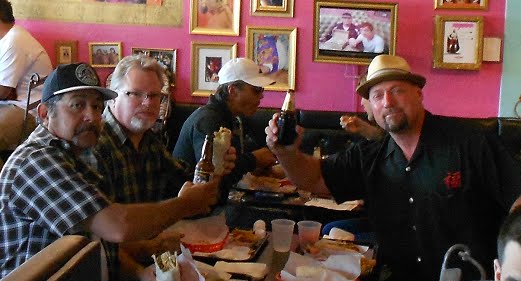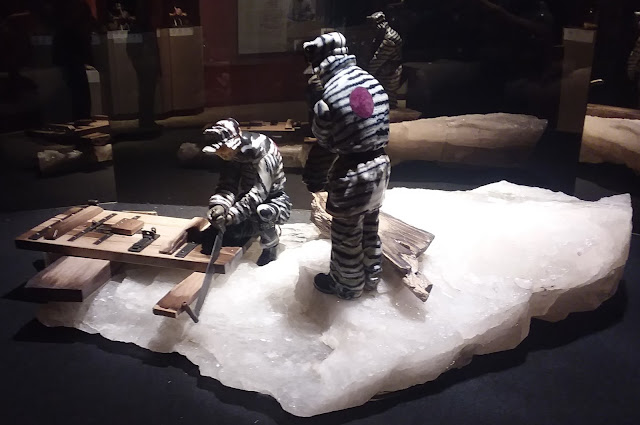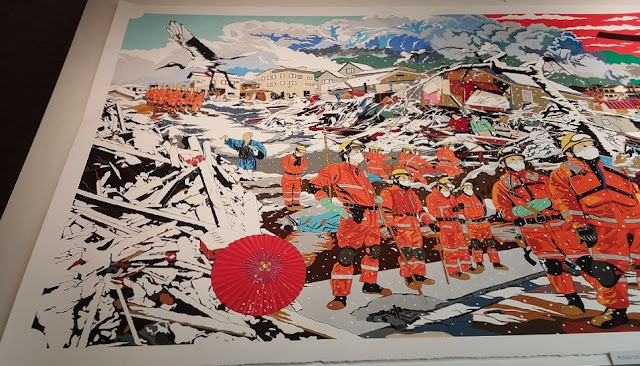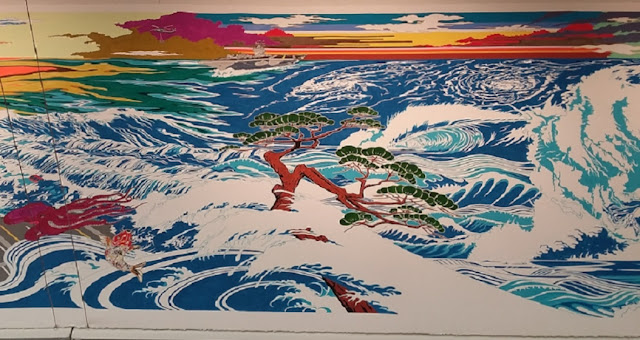The art, adventures, wit (or lack thereof), verse, ramblings, lyrics, stories, rants & raves of Christopher R. Bakunas
Eddie Arana, Rick Thibodeau, & Chris Bakunas San Diego, Ca. March 2012

Eddie Arana, Rick Thibodeau, & Chris Bakunas at Luche Libre Taco Shop in San Diego, March 2012
Saturday, March 31, 2018
Friday, March 30, 2018
Not Quite An Eggs & Bacon Man...
He could no longer remember a time when he didn't start the day with a couple of aspirin for breakfast
Or end the day with a six course dinner that came in 12 ounce cans with easy to open pop tops
However, he did not think either of those habits to be a negative aspect of his life
After all, he was still somewhat physically fit - which he had decided was a fact because he could tie his shoes without getting winded and did not quite look like a squished loaf of bread when he was sitting down
And occasionally, when he was shaving and caught sight of his face in the mirror - when his head was tilted at just the right angle, and the second bulb in the light fixture was out - he thought he could still pass for a reasonably handsome man
However, he always kept in mind the fact that, despite any and all of his ideas of who he was or what he looked like, the truth of the matter was it all came down to perception
Specifically, the perception of him by others.
That was the one thing that had bugged him for his entire life. Other peoples perception.
Which is why he no longer went out, and why he had so many pets (three cats, five dogs, and a turtle - though he hadn't seen the turtle in over a month)
He was terrified of being erroneously perceived, as he had never learned the lesson that what other people thought of him was not only unimportant, but really none of his business
So he sat at home, in front of the TV if he was feeling lazy, in front of the computer if he was feeling social, and snuggled up in his big recliner with a book if he was feeling adventurous
With a handle of Jack and a bag of chips on the small table, and every so often a large bag of M&Ms.
Which was, of course, what had lead to the aspirin for breakfast routine
Or end the day with a six course dinner that came in 12 ounce cans with easy to open pop tops
However, he did not think either of those habits to be a negative aspect of his life
After all, he was still somewhat physically fit - which he had decided was a fact because he could tie his shoes without getting winded and did not quite look like a squished loaf of bread when he was sitting down
And occasionally, when he was shaving and caught sight of his face in the mirror - when his head was tilted at just the right angle, and the second bulb in the light fixture was out - he thought he could still pass for a reasonably handsome man
However, he always kept in mind the fact that, despite any and all of his ideas of who he was or what he looked like, the truth of the matter was it all came down to perception
Specifically, the perception of him by others.
That was the one thing that had bugged him for his entire life. Other peoples perception.
Which is why he no longer went out, and why he had so many pets (three cats, five dogs, and a turtle - though he hadn't seen the turtle in over a month)
He was terrified of being erroneously perceived, as he had never learned the lesson that what other people thought of him was not only unimportant, but really none of his business
So he sat at home, in front of the TV if he was feeling lazy, in front of the computer if he was feeling social, and snuggled up in his big recliner with a book if he was feeling adventurous
With a handle of Jack and a bag of chips on the small table, and every so often a large bag of M&Ms.
Which was, of course, what had lead to the aspirin for breakfast routine
Thursday, March 29, 2018
...And That's What Started The Agreement...
Nothing about the guy struck me as being right. Everything about him seemed to be absolutely wrong.
The way he was dressed, the way he carried himself, his demeanor...hell, even the way he combed his hair was just not quite...right.
Then he asked the question: "What is it about opening day that is just...magical?"
That was all it took. After I heard those words all I could think was, "I don't care if this cat is here to rob the place, he's alright with me."
The way he was dressed, the way he carried himself, his demeanor...hell, even the way he combed his hair was just not quite...right.
Then he asked the question: "What is it about opening day that is just...magical?"
That was all it took. After I heard those words all I could think was, "I don't care if this cat is here to rob the place, he's alright with me."
Wednesday, March 28, 2018
Sinus Augment, Vertical Approach
Such a grand and glorious day. A truly fine day for sitting in a Dentist chair for two and a half hours.
Yes indeed, nothing quite like having a guided tiss regen-resorb-per, Surg place implant: endosteal (sic), Bone Graft, Implant Placement, Sinus Augment, Vertical Approach, Guided tiss regen-resorb-per, Surg place implant: endosteal (sic), Bone Graft, Implant Placement...
That's what the sheet of paper with the extraordinarily large bill for services says on it. In layman's terms, I had two dental implant seats put into my right side upper jaw today. In four to eight months I'll have the posts and crowns placed.
Oh, the sheer thrill of it all...
Tuesday, March 27, 2018
Monday, March 26, 2018
Saturday, March 24, 2018
Friday, March 23, 2018
Thursday, March 22, 2018
The Fantastic Gem Sculptures Of Vasily Konovalenko
Vasily Konovalenko (1929 - 1989) was a man who led quite an extraordinary life. Born in Ukraine to a Ukrainian father and a Russian mother when Ukraine was under the heel of the Soviet Union.
As a young man he displayed pronounced artistic abilities, with particular skill as a sculptor. The 1930's were rough for young artistic types though, especially in that area of the world, what with the world wide depression, the famines throughout the USSR caused by the disastrous Stalinist 5-year plans, and of course, the Nazis.
Vasily survived WWII, which may not seem at all unusual as he was only 11 to 15 during the war, but do a little research and you'll discover that being a 11 to 15 year old boy in the USSR during WWII was fairly dangerous.
At the tail end of the war he was enrolled in a trade school (as all Soviet "citizens" were then required to be) but afterward somehow managed to get a position at the Stalin Theater for Opera & Ballet as a set designer, and then enroll in the art and architecture school at the Donetsk Polytechnic Institute.
By 1950 he was working in the Stalinist Regional Association of Artist as a sculptor, and seemed to be secure in his desired career as a creative artist.
However, he was drafted into the Soviet Navy, which threw a big wrench into his plans.
His service in the Soviet Navy was short lived however, as he was booted out after only 5 months for undisclosed medical reasons. The short while he was in the service had exposed him to the city of Leningrad (St Petersburg), and the long history of artistic appreciation that was an integral part of that cities cultural identity.
He moved to Leningrad after being dismissed from the Soviet Navy, and found work as the lead set designer for the Kirov State Academic Theater of Opera & Ballet (now known as the Mariinsky Theater), a position which inadvertently introduced him to the art of gem and mineral carving, and which, over the course of 16 years of employment there, allowed him to develop a unique talent for creating highly detailed small sculptures out of gemstones and minerals.
However...his desire to have those sculptures displayed at the State Russian Museum in Moscow led to him running afoul of a few particularly nasty high-ranking Soviet officials, as not only did he and his wife violate the required protocols of the being introduced up the ladder until they got to the actual official who could decide whether or not to display his work (they literally had just went around the seemingly endless levels of bureaucrats and showed up at the Moscow offices of the ones who could make the decision), but the subject matter of Vasily's sculptures, Russian folk life, was not in line with what the Communist Party deemed to be acceptable art.
Which lead to Vasily and his wife being booted out of Moscow and sent back to Leningrad with a Soviet equivalent of "Don't call us, we'll call you".
That discouraged Vasily for awhile, but two years later he & his wife tried again, this time returning to Moscow with the proper introductions and sculptures that were more in line with what the Communist party considered appropriate.
The result was success beyond the pale - his sculptures were viewed by powerful Soviets who approved a showing of his work at the State Russian Museum in Leningrad, and that showing was a huge success.
However...having Moscow-based Soviet bigwigs approve a show in Leningrad angered a few Leningrad-based Soviet bigwigs (Soviet bigwigs were constantly involved in power struggles and were constantly looking for ways to look good in the eyes of their superiors) The Leningrad-based Soviet bigwigs decided to make life hell for Vasily and his family, engaging the KGB to investigate him as a possible traitor to the USSR and as a criminal illegally trading in gemstones, minerals, gold & silver.
The Konovalenko's survived the charges and investigation due to the intervention of friends, but they had to leave Leningrad for Moscow, and had to turn over all of his sculptures to the state.
Needless to state, Vasily did not appreciate all that he and his family had to endure at the hands of the state, and decided to leave the USSR.
At the time (mid '60's to early '80's) the USSR had a program that would allow Russian Jews to emigrate to Israel. Vasily wasn't Jewish...but his wife was. They applied for the program and in 1981 they were approved for exist visas, which they used to get to New York City (Vasily's wife had a brother who lived there).
With the help of various friends, Vasily and his sculptures were soon in front of people who not only appreciated them, but would sponsor him to create more.
The sculptures, of course, would need to be put on display and one of the sponsors, a diamond merchant named Jack Ortman, had a client by the name of Alvin Cohen who was a trustee at the Denver Museum of Nature & Science.
Mr. Cohen was shown the sculptures and agreed to arrange for an exhibition. It took a bit of time and work, but eventually, on March 15th 1984 at the Denver Museum of Nature & Science, for the first time outside of the USSR, Konovalenko's sculptures were seen by the public.
Over the next 5 years Alvin Cohen purchased all of the sculptures that Konovalenko's original New York sponsors had commissioned him to create (20 in all) and in 1999 (10 years after Konovalenko's passing on January 27th 1989), Mr. Cohen donated them to the Denver Museum of Nature & Science, where they remain on permanent display.
Monday, March 19, 2018
The Grand Re-Opening Of The Relocated Kirkland Museum of Fine & Decorative Art
Here in Denver, the weekend of March 10th & 11th marked the grand re-opening of the Kirkland Museum of Fine & Decorative Art.
A little more than 5 years ago, in February of 2013, I wrote about the museum when it was still located on the corner of 13th & Pearl. In May of 2016, that location was closed and the three-room studio that Vance Kirkland taught art classes and created works of art in for over 40 years was lifted off it's foundation and moved 8 blocks west down 13th street to a large lot on the corner of 12th and Bannock, directly across the street from the Denver Art Museum and the Clyfford Still museum, in an area of Denver known as the Golden Triangle.
Once the studio was situated on a foundation at it's new home, construction began on a much larger museum (like, 30,000 square feet larger than the old museum) to house the three large collections that had been crammed into the old, 8,000 square foot museum.
The new place is impressive. Designed by Seattle firm Olsen-Kundig, it is everything a museum designed to be a home to an impressive collection of fine art and the best examples of 20th century decorative arts - everything from William Morris rugs and Gus Stickley furniture, to Rookwood pottery, needs to be.
A little more than 5 years ago, in February of 2013, I wrote about the museum when it was still located on the corner of 13th & Pearl. In May of 2016, that location was closed and the three-room studio that Vance Kirkland taught art classes and created works of art in for over 40 years was lifted off it's foundation and moved 8 blocks west down 13th street to a large lot on the corner of 12th and Bannock, directly across the street from the Denver Art Museum and the Clyfford Still museum, in an area of Denver known as the Golden Triangle.
Once the studio was situated on a foundation at it's new home, construction began on a much larger museum (like, 30,000 square feet larger than the old museum) to house the three large collections that had been crammed into the old, 8,000 square foot museum.
The new place is impressive. Designed by Seattle firm Olsen-Kundig, it is everything a museum designed to be a home to an impressive collection of fine art and the best examples of 20th century decorative arts - everything from William Morris rugs and Gus Stickley furniture, to Rookwood pottery, needs to be.
Sunday, March 18, 2018
One Little Tweak In The Wiring
If every single bite of every single carbohydrate-filled pasta dish I ever ate burned my throat as if acid was washing down it, I would be super-fit
Thursday, March 15, 2018
Monday, March 12, 2018
Museum Of Nebraska Art Nebraska Now Jave Yoshimoto Showcase
Since 1994 the Museum of Nebraska Art in Kearney, Nebraska, has featured 4 annual exhibitions that feature an artist who currently lives and creates art in Nebraska. The showcase on display when we paid the museum a visit consisted of the work of Jave Yoshimoto, an Asian-American artist who has developed a unique contemporary interpretation of traditional Japanese and Chinese scroll painting.
There are many engaging pieces of Mr Yoshimoto's work on view at the MONA, but by far the most arresting/compelling piece in the exhibition is his 3 & 1/2 foot by 30 and 1/2 foot scroll titled Baptism of Concrete Estuary.
This remarkable piece of art was created by Mr. Yoshimoto as both a memorial to the thousands of men, women & children who lost their lives as a result of the 2011 Japanese earthquake and subsequent tsunami that hit the pacific coast of Japan, and as a commentary on the fleeting nature of disasters of that mind-numbing magnitude becoming just another story slated to be lost in the 20-minute update news cycles of major cable news networks.
It's not often that I feel compelled to post links to any other sites, but the artwork and mission of this talented individual more than merits it. Pay him a visit at www.javeyoshimoto.com
There are many engaging pieces of Mr Yoshimoto's work on view at the MONA, but by far the most arresting/compelling piece in the exhibition is his 3 & 1/2 foot by 30 and 1/2 foot scroll titled Baptism of Concrete Estuary.
This remarkable piece of art was created by Mr. Yoshimoto as both a memorial to the thousands of men, women & children who lost their lives as a result of the 2011 Japanese earthquake and subsequent tsunami that hit the pacific coast of Japan, and as a commentary on the fleeting nature of disasters of that mind-numbing magnitude becoming just another story slated to be lost in the 20-minute update news cycles of major cable news networks.
It's not often that I feel compelled to post links to any other sites, but the artwork and mission of this talented individual more than merits it. Pay him a visit at www.javeyoshimoto.com
Friday, March 9, 2018
The Great Platte River Road Archway Monument Over I-80 In South Central Nebraska
I have driven along I-80 through Nebraska (coming and going to points east & west) somewhere between "a lot" and "maybe a little more than that" over the past 15 years or so, and each and every time I have driven under the huge archway that spans the interstate a few miles east of Kearney I have said to myself, "I really should take the exit for this thing and see what it's all about."
And, until this past week, that's all I ever did - told myself the aforementioned, then kept on driving.
Finally I took the opportunity to investigate the huge archway (and by huge, I mean a 300 foot span that weighs in the neighborhood of three million pounds).
And whattaya know, it was worth every minute of the visit.
First off, the Archway Monument houses a museum inside it, and outside it, too - the area around the Archway has a fair amount of interesting historical artifacts that dot a short pedistrian/bicycling path - such as the reproduction of a early Prairie settler's one room sod house shown below.
Second, the displays inside (and outside) the museum are very well put together, and extremely educational.
In a nutshell, the Archway is a monument to the hardy pioneers who blazed the trails that crossed the great plains and the Rocky Mountains and on into the western states.
The museum houses life-size displays featuring travelers on the California and Oregon trails, the Mormon trail (they used handcarts to carry their belongings!), Pony Express routes, the birth and growth of the railroads, and the eventual construction of the transcontinental highways.
It's a tribute to some very tough people, one I highly recommend visiting should you ever be driving along I-80 in the heart of the United States.
Thursday, March 8, 2018
Subscribe to:
Posts (Atom)


















































